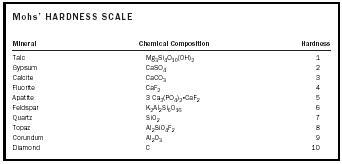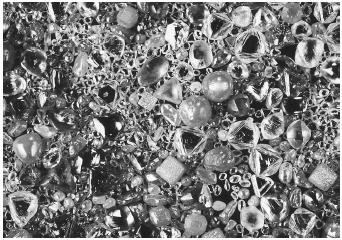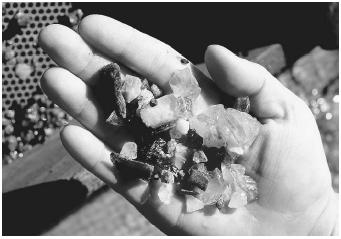Gemstones
There are several thousand known minerals in nature (with estimates ranging from 2,000 to 7,000), but fewer than a hundred are considered gem minerals. Of these, only about a dozen or so are actually valuable enough to be important gemstones on the world market. In order to be considered a gemstone, a mineral must first of all be beautiful. In addition, it must be hard and durable. Its value increases if it is also rare.
The beauty of a gem is measured in terms of its clarity, brilliance, and color. Its natural beauty can be enhanced by the way it is cut. There are two basic kinds of gem cuts: faceted and cabochon. The faceted cut has many flat cut surfaces (facets) with an overall shape that might be round, oval, square, rectangular, or pear-shaped. Faceted cuts are preferred for brilliant transparent stones such as diamond. The cabochon cut has a smooth rounded top, usually with a flat base, and it is mainly used for opaque or translucent stones.
Hardness is measured using the Mohs' scale, on which 10 is hardest. (Diamond has a hardness of 10.) Gemstones should have a Mohs' hardness of 6 or more. A really durable gem should have a hardness of at least 7, which is the hardness of quartz. Table 1 shows the hardness of some familiar minerals on the Mohs' scale.
The value of a gemstone depends on its beauty and its rarity, but also the size of the stone. Size is measured in terms of weight using the carat as a unit. A carat is 0.2 grams (0.007 ounces). (A 10-carat diamond weighs 2 grams, or 0.07 ounces.) There are 100 points in a carat, so a 30-point diamond weighs 0.3 carat, or 0.06 grams (0.002 ounces). Since gemstones vary in density (weight per unit volume), several different 1-carat stones may vary in size, the stones with the greatest density being smaller than the others.
Some Important Gemstones
Diamond is the hardest substance known to occur in nature, measuring 10 on the Mohs' scale. It is pure carbon in a tightly packed cubic structure. Diamonds are usually graded on the basis of four Cs: carat, cut, clarity, and color. Carat refers to the stone's weight and degree of flawlessness. As for color, diamonds are usually colorless, but sometimes they do exhibit color. The famous Hope diamond, for example, is blue. Most diamonds come from mines in Africa, especially southern Africa, although Russia and Australia also have diamond mines. Industrial-grade diamonds have even been made synthetically at very high pressures and temperatures. A number of other softer colorless stones are often sold as imitation diamonds.
Ruby is a variety of corundum (Al 2 O 3 ) with a Mohs' hardness of 9. Its red color results when chromic ions (Cr 3+ ) replace some of the aluminum ions in the crystal. The finest rubies come from Myanmar (formerly Burma) or Kenya. Star rubies are stones with a special starlike appearance. They usually have a cabochon cut and appear to show a 6-pointed star due to microscopic inclusions. Rubies of very high quality are sometimes made synthetically.
Sapphire, like ruby, is made of corundum (Al 2 O 3 ) and has a hardness of 9. However, instead of Cr impurities, the crystal contains iron and titanium

| Mohs' HARDNESS SCALE | ||
| Mineral | Chemical Composition | Hardness |
| Talc | Mg 3 Si 4 O 10 (OH) 2 | 1 |
| Gypsum | CaSO 4 | 2 |
| Calcite | CaCO 3 | 3 |
| Fluorite | CaF 2 | 4 |
| Apatite | 3 Ca 3 (PO 4 ) 2 •CaF 2 | 5 |
| Feldspar | K 2 Al 2 Si 6 O 16 | 6 |
| Quartz | SiO 2 | 7 |
| Topaz | Al 2 SiO 4 F 2 | 8 |
| Corundum | Al 2 O 3 | 9 |
| Diamond | C | 10 |
ions, which produce a blue color, ranging from very pale to very dark blue. Sapphires are found in Cambodia and other places in Southeast Asia and Australia, as well as Montana in the United States. Also, as in the case of rubies, there are star sapphires, which exhibit a 6-pointed star. Pure corundum (white sapphire) was the first gem to be produced synthetically. It was a poor substitute for diamond, however, because of its low refractive index. Adding about 0.1 percent chromium, however, produces rubies of excellent quality; and the addition of iron and titanium yields beautiful blue sapphires. Even star sapphires and rubies that rival natural stones can be made synthetically.
Emerald is a variety of beryl, a beryllium silicate, with a hardness of 7.5 to 8. It has a beautiful deep green color, and it is one of the most expensive gems, sometimes outranking diamond in value. The green color results from small amounts of chromic oxide (Cr 2 O 3 ). The oldest emerald mines were in Egypt near the Red Sea, but the best emerald mines today are in Colombia. There are others in Brazil, Pakistan, and Africa; synthetic emeralds of excellent quality have also been manufactured.
Aquamarine, like emerald, is a transparent variety of beryl, or beryllium silicate. Its light blue to blue-green color results from small amounts of iron in the crystal. Like most beryl stones, it measures 7.5 to 8 on the Mohs' hardness scale. Most aquamarine gemstones come from Brazil.
Topaz is a rather rare silicate mineral with a Mohs' hardness of 8. It comes in many colors from yellow to pink to purple to blue, depending on what ions are present in the crystal. It can even be colorless. However, the favorite variety is orange to brown in color and called "imperial topaz." Much of the best topaz comes from Brazil. The gem called London blue topaz can be made from the colorless variety by treatment with heat and radiation.
Cubic zirconia (ZrO 2 ), with a Mohs' hardness of 8, is a beautiful, usually colorless, stone that is made synthetically. Although not as hard as diamond, cubic zirconia has much fire and brilliance, and it is popular as an imitation diamond. Zirconia normally has a monoclinic crystalline structure at room temperature, but when heated to about 2,300°C (4,172°F), it takes on a cubic structure. Ordinarily, it would revert to the monoclinic structure on cooling, but the addition of yttrium oxide (Y 2 O 3 ) or calcium oxide (CaO)

can stabilize the zirconia so that it retains the cubic structure at room temperature. Cubic zirconia has optical properties very close to those of diamond, and it is clearly the best of all the various diamond imitations.
Zircon is native zirconium silicate (ZrSiO 4 ) that exhibits beautiful transparent crystals and a Mohs' hardness of 7.5. The tetragonal crystals are usually brownish yellow in color. Also known as jargon or jargoon, zircon is a stable and durable silicate crystal. Small crystals of zircon are among the oldest mineral grains ever found on Earth.
Opal is a hydrous silica (SiO 2 ), sometimes thought of as an amorphous silica gel. It is a fairly soft gem, measuring only 5 to 6 on the Mohs' scale. It is relatively common in nature except in its "precious" form, which comes mainly from Australia. In Switzerland, since 1970, opal of precious quality has been made synthetically. Usually cut in the cabochon shape to permit its rainbowlike display of color, opals come in white, black, and fire varieties. "Black" opals are dark gray to blue, and fire opals, which are more transparent than other opals, are usually orange-red in color.
Amethyst is a variety of quartz (SiO 2 ) that is violet to purple in color, probably because of iron and manganese impurities. It measures 7 on the Mohs' hardness scale and is obtained from many places, but mainly from India and Brazil. It should not be confused with oriental amethyst, which is a purple native variety of alumina (Al 2 O 3 ).
Spinel is a colorless magnesium aluminate (MgAl 2 O 4 ) of cubic structure. It is hard and durable, but, like white sapphire, it is not a good diamond substitute because it has a low refractive index and lacks brilliance. However, it is readily doped to produce other gems of various colors. Artificial ruby, for example, is often natural red spinel, and most synthetic blue sapphires on the market are actually blue spinel.
Peridot is the gem variety of olivine, a magnesium silicate containing iron (about 9 Mg atoms for every Fe atom). Peridot is usually transparent,

with a color ranging from greenish yellow to brownish green. Much peridot comes from an island in the Red Sea, but it is also found in Myanmar and an Apache reservation in Arizona.
Garnet is actually a group of related silicates containing various amounts of magnesium, calcium, aluminum, iron, manganese, and chromium. Garnets have a hardness of 6.5 to 7.5, depending on their composition, and their color also varies along with their composition. The popular dark red garnets are found in many gem sites in the Czech Republic, but garnets of many colors are also found in other parts of the world, such as India, Tanzania, Russia, and Brazil.
Tourmaline is a highly complicated silicate, with a wide range of compositions and colors. It probably exhibits more colors than any other kind of gemstone. Sometimes there are several different colors in the same crystal. "Watermelon" tourmaline, for example, is green on the outside but red in the middle.
Lapis lazuli is a deep blue gemstone that is a complex copper silicate mineral varying widely in composition. It often contains sparkles of iron pyrite or calcite. The best source is probably Afghanistan. A pale blue variety is found in Chile. Some material sold as lapis lazuli is actually artificially colored jasper from Germany.
Onyx is a striped variety of the common silicate mineral called agate, with alternating black and white bands. It comes mainly from India and South America. Sardonyx is a variety of onyx with brown and white bands.
"Organic" Gems
The aforementioned gemstones, unless they are synthetic, usually occur in underground deposits from which they are mined. However, there are some gems that come from once living material.
Pearls are little spheres of calcium carbonate (CaCO 3 ) that form in mollusks ( invertebrate shellfish) such as oysters, usually because of some sort of irritation. They are normally white or off-white in color, but they can have bluish or pink tints, and sometimes they are dark gray. Although many pearls form naturally, pearl production has been greatly increased by the "cultured" pearl industry, which raises beds of oysters into which irritants are routinely introduced. The irritants are usually bits of mother-of-pearl, the lining that forms inside oyster shells.
Amber is fossilized tree resin that hardened over millions of years and now is valued as a gem. Baltic amber is thought to be hardened sap from pine trees. It is normally yellow-brown in color, but the shades vary from almost white to almost black. Although sometimes completely clear, amber often contains inclusions of insects or other matter, often considered desirable. Much amber is obtained along the shores of the Baltic Sea, but it is also found along the coasts of Sicily, Romania, and Myanmar.
Coral, like pearls, is calcium carbonate (CaCO 3 ) derived from living matter. It is the outer shells of small marine animals. It occurs in many colors, from white to deep pink and red. The greatest demand is for red coral. The best coral comes from the Mediterranean Sea, along the coasts of Algeria and Tunisia.
Ivory is a bonelike material that comes from the tusks of animals (elephant, walrus, hippopotamus). It has become such a highly prized material that there are unscrupulous poachers who kill these animals in order to steal their tusks. The pale cream color of new ivory becomes darker with age and turns yellow. Ivory is brittle, but it does not peel as do its plastic substitutes.
Jet is actually just a very hard and dense kind of lignite coal. It was probably plant material millions of years ago that has become fossilized and blackened over time. It often comes from northeast England, where it is derived from fossil driftwood buried under the sea. Its primary drawback as a gemstone is that it will burn (since it is basically just highly polished coal).
AMBER AND ELECTRICITY
Ancient Greeks called amber elektron. When they rubbed it with a cloth, it became charged and attracted bits of paper. The word "electricity" derives from the Greek word elektron.
Bibliography
Delinsky, Barbara (2001) Gemstone. New York: Harper Torch.
Hall, Cally (1994). Gemstones. New York: Dorling Kindersley.
Kraus, Edward Henry (1931). Gems and Minerals. New York: McGraw-Hill.
Matlins, Antoinette L., and Bonanno, A. C. (1997). Gem Identification Made Easy, 2nd edition. Woodstock, VT: Gemstone Press.
Pellant, Chris, and Russell, Henry (2001). Encyclopedia of Rocks, Minerals, and Gemstones. San Diego, CA: Thunder Bay Press.
Schumann, Walter (1997). Gemstones of the World, revised edition. New York: Sterling.
Smith, Richard Thomas (1958). Gemstones. New York: Pitman.
Spencer, Leonard James (1959). A Key to Precious Stones. New York: Emerson.
We looking information of Gemstone by chemistry = phosphate + sodium = what is the name ?
Thank you,
Alfi Mulia